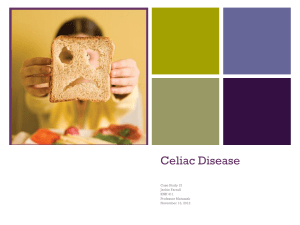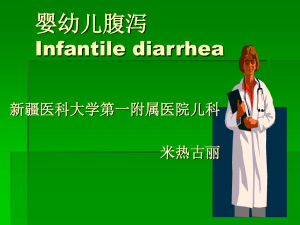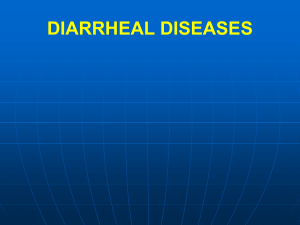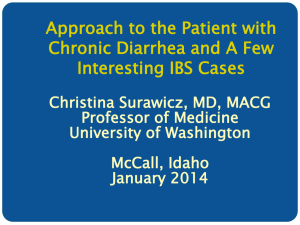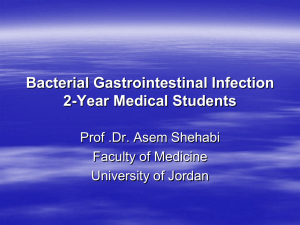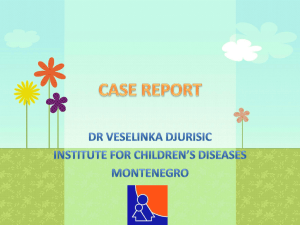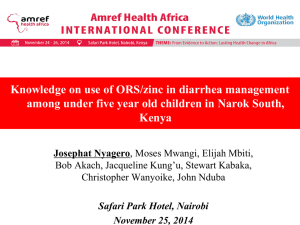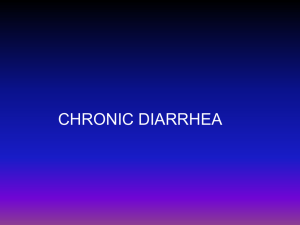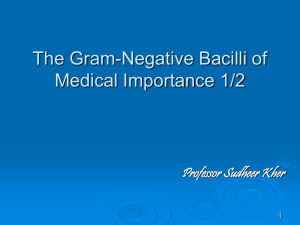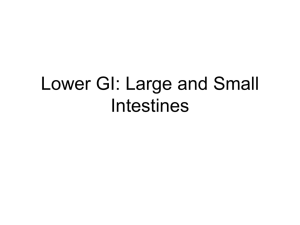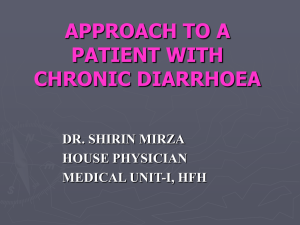Chronic Diarrhea
advertisement
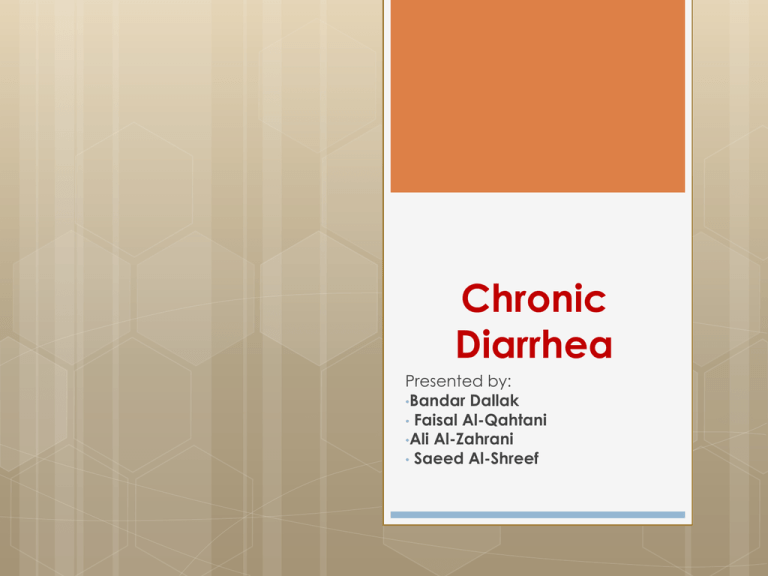
Chronic Diarrhea Presented by: •Bandar Dallak • Faisal Al-Qahtani •Ali Al-Zahrani • Saeed Al-Shreef Introduction: Diarrhea is an increase in fluidity, volume and frequency of stools relative to the usual habits of an individual. ≥ 3/day loose, watery stool. Introduction: The great majority of diarrhea episodes last less than one week; When diarrhea persists for more than 14 days, it is called persistent, intractable, or chronic diarrhea. Introduction: In the developing world, persistent diarrhea usually follows an acute episode and typically is associated with serial enteric infections without time to recover between episodes. Children are at risk of malnutrition and often have other intercurrent illnesses, such as respiratory infections. Introduction: In developed countries, children are less likely to be exposed to serial enteric infections and malnutrition. In these populations, chronic diarrhea is more likely to be caused by underlying disease, such as celiac disease or other food allergy. Introduction: Sequelae: Dehydration. Marked weight loss and malnutrition. FTT. There are four basic pathophysiological categories of diarrhea (1) Osmotic Diarrhea: when an ingested solute is not absorbed properly, the higher concentration gradient within the gut lumen acts to draw water into intestinal lumen and greatly increases the water content of the stool. The classic example of this is the diarrhea caused by lactose intolerance. Enteric infections may also cause malabsorption via damage to intestinal epithelial cells (ex. Rotavirus or Shigella). (2) Secretory Diarrhea: this diarrhea is caused by the intestine actively secreting water into the gut lumen. Infections such as Cholera, Clostridia Perfringens, Clostridia Difficile, E. Coli, Staph. Aureus, and Shigella all cause secretory diarrhea mainly via preformed enterotoxins. (3) Inflammatory Diarrhea: Intestinal inflammation can lead to blood, mucus, and protein exudate losses, accompanied by fluid and electrolytes. The most common cause of this type of diarrhea is infection but can also be due to chronic diseases such as IBD or Celiac Disease. (4) Diarrhea due to Motility Disorders: although uncommon, both an increase and a decrease in gut motility can be a cause of diarrhea. Note: diarrhea can be caused by one or any combination of these categories Causes CAUSES: Viral, parasitic, bacterial,.. Infections IBS Endocrine IBD Celiac disease. •Hyperthyroidism. •Adrenal insufficiency. Chronic nonspecific diarrhea. Small intestine Chronic Diarrhea Cystic fibrosis. Carbohydr ates malabsorpt ion Pancreas Familial chloride diarrhea. Metabolic defects Dietary Immune defects Agammaglobulinemia IgA deficiency. AIDS. •Lactase deficiency. •Glucose-glactose malabsorption. Cow’s Milk/soy protein intolerance. Bacterial •Salmonella. •Campylobacter •Antibiotic induced: C. difficile Parasitic • Giardasis. •Ascaris. •Amoeba. •Ankylostoma. Post infectious •secondary lactase deficiency Infections Typhoid: Caused by S. typhi and S. paratyphi. Transmitted through contact with infected animals e.g., chicken, or through contaminated food e.g., eggs, dairy products. Typhoid: C/P: Bactremia and high grade fever that usually precede the enteric phase. Diarrhea (usually after 1 week) Abdominal pain. Nausea. Loss of appetite. CNS signs ( severe) : coma, meningism, fits.. If untreated, the disease persists 2-3 weeks with marked weight loss, hematochezia, melena. Typhoid: Treatment: Ciprofloxacin (best) Alternative for ciprofloxacin resistance Ceftriaxone or azithromycin Co-trimoxazole (TMP-SMZ) Dexamethazone Parasitic: Giardia Lamblia. Entamoeba histolytica. Cryptosporidium parvum. Amebiasis: C/P: Intestinal: Acute onset of mild diarrhea. or Amebic dysentry: perfuse diarrhea with blood, tenesmus, severe abd. pain Extra intestinal: - amebic liver abscess (fever, sweats, RUQ pain, high WBCs..) -may invade lung or brain also.. Amebiasis: Diagnosis: Stool microscopy Fecal antigen detection Serology US/CT .. Aspiration Treatment: metronidazole: With diloxanide furoate (cyst) Tinidazole ( severe ) Giardia lamblia: is transmitted through ingestion of cysts from contaminated food or drinks. Adheres to microvilli of dudenal or jejunal epithelium. Giardia lamblia: C/P : diarrhea Bloating , flatulence Abdominal pain Explosive diarrhea Malapsorption Weight loss Diagnosis: Direct fluorescent antibody (DFA) >> gold standard Stool microscopy>> may be (--) Treatment: Tinidazole paromomycin Celiac Disease Celiac Disease: abnormal small intestine mucosa due to intestinal reaction to gliadin, a component of gluten. Etiology Only autoimmune disease in which androgen (alphagliadin) is recognized. Associated with other autoimmune diseases, especially thyroid disease. Gluten, a protein in cereal grains, is toxic factor. Associated with HLA-DQ2 and with HLA-DQ8 Celiac Disease: Clinical Features classically: diarrhea, weight loss, anemia, symptoms of vitamin/ mineral deficiency, failure to thrive; now more commonly bloating, gas, iron deficiency. improves with gluten-free diet, deteriorates when gluten reintroduced. disease is usually most severe in proximal bowel; therefore iron, calcium, and folic acid deficiency common Celiac Disease: Investigations: small bowel mucosal biopsy (usually duodenum) : villous atrophy and crypt hyperplasia increased number of plasma cells and lymphocytes in lamina propria. Celiac Disease: Investigations: Evidence of Malabsorption: Steatorrhea Low levels of ferritin/iron saturation, Ca, Fe, albumin, cholesterol, carotene, B12 absorption Celiac Disease: Investigations: Serology: anti-transglutaminase antibodies, TTG Fecal fat >7% over 72 hrs Celiac Disease: Treatment: Dietary counselling: Gluten free diet: avoid barley, rye, wheat, maybe oats (if not contaminated by other grains). Starchy foods e.g., rice are safe. Iron, folate supplementation (with supplementation of other vitamins as needed) Celiac Disease: Prognosis: associated with increased risk of lymphoma, carcinoma including small bowel and colon. These can be avoided if adherent to diet. Cystic Fibrosis Cystic Fibrosis: Autosomal Recessive. Gene on long arm of chromosome 7 encoding for CFTR (Cystic Fibrosis Transmembrane Regulator). CFTR is a Chloride channel regulating Chloride transport and possibly sodium. This is responsible for elevated sweat chloride in 99% of patients. Cystic Fibrosis: CF is characterized by widespread exocrine dysfunction. Cystic Fibrosis: GI Manifestation: More prominent in infants. Meconium ileus. Greasy stools and fl atulence. Pancreatitis. Biliary cirrhosis. Jaundice. Cystic Fibrosis: GI symptoms are more prominent in infancy, while pulmonary manifestations predominate thereafter. Cystic Fibrosis: Dx.: Sweat chloride Test: > 60 mEq/L. Genetic analysis: Are confirmatory. Cystic Fibrosis: Others: DM. Infertility. Unexplained hyponatremia. Fat soluble vitamins (A, D, E, K) deficiency. ..etc. Cystic Fibrosis: Management.: Pulmonary manifestations :are managed with chest physical therapy, bronchodilators, corticosteroids, antibiotics, and DNase. Administer pancreatic enzymes and fat-soluble vitamins A, D, E, and K for malabsorption. Nutritional counseling and support with a high-calorie and high-protein diet are essential for health maintenance. Crohn’s Disease Ulcerative Colitis IBD Inflammatory Bowel Diseases IBDs: Epidemiology: More common Jewish. The incidence of IBDs is increasing especially in industrialized countries. Environmental factors are needed to drive the disease in genetically susceptible individuals. 30 folds increased risk in those with first degree relatives involved. Crohn’s Disease: May The involve any part of GIT. commonest site is illeocecal junction. Discontinuous Rectum pattern “ SKIP LESIONS ”. is often spared. Crohn’s Disease: C/P: Abdominal pain. Abdominal tenderness. Abdominal mass. Low grade fever. Weight loss. Watery diarrhea. Perianal fissure/fistula. Ulcerative Colitis: Mainly The affect the colon. rectum is always involved. May extend proximally in a continuous fashion. Ulcerative Colitis: C/P: Bloody diarrhea. Lower abdominal cramps. Tenesmus. Urgency. Abdominal pain/tenderness. Blood on rectum. Usually, no abdominal mass. Extraintestinal Manifestations of IBDs: Aphthous stomatitis, Episcleritis/uveitis, Arthritis, Erythema nodosum, Pyoderma gangrenosum. Inflammatory Bowel Diseases IBDs: Investigations: Blood test. Endoscopy. Colonscopy.(biopsy) Plane Abdominal XR. US, CT. Inflammatory Bowel Diseases IBDs: Management: 5-ASA. Steroids. Azathioprine. Infliximab MTX. -surgical Glucose-galactose malabsorption Glucose-Galacose Malabsorption: a condition in which the cells lining the intestine cannot take in the sugars glucose and galactose. Generally becomes apparent in the first few weeks of a baby's life. Glucose-Galacose Malabsorption: C/P: Severe diarrhea. Life-threatening dehydration, Increased acidity of the blood and tissues (acidosis), and weight loss This occurs when fed breast milk or regular infant formulas. Glucose-Galacose Malabsorption: C/P: However, they are able to digest fructose-based formulas that do not contain glucose or galactose. Some affected children are better able to tolerate glucose and galactose as they get older. Glucose-Galacose Malabsorption: C/P: Small amounts of glucose in the urine (mild glucosuria). Affected individuals may also develop kidney stones or more widespread deposits of calcium within the kidneys. Familial Chloride Losing Enteropathy Familial Chloride Losing Enteropathy: An inherited defect of chloride absorption in ileum and colon. Defect in chloride-bicarbonate exchange protein. Presents since birth with abdominal distension and watery diarrhea. Approach History: Age: Duration: Consistency? Blood? Mucus? Pus? Offensive? Frequency? Volume? Associated symptoma: Vomiting? Fever? Abdominal pain? Tenesmus? Convulsion? Cough? Appetite? Weight loss? Height intolerance? Tremorr? Type and quantity of milk? Food? History: Allergy to food? Past history of similar attack? How frequent? Past Medical and Surgical Histoty? Family hx of a similar condition? Living conditions? Drug history? Travel history? PHYSICAL EXAMINATION GENERAL: General appearance and mental status Vital signs Growth Parameters: FTT??? Hydration assessment. Orthostasis- volume depletion,autonomic dysfunction Pallor? Exophthalmos (hyperthyroidism) Aphthous ulcers (IBD and celiac disease) Lymphadenopathy (malignancy, infection or Whipple's disease) Thyroid Examinations: Clubbing (liver disease, IBD, laxative abuse, celiac disease,) SKIN LESIONS Dermatitis herpetiformis (celiac disease) Erythema nodosum and pyoderma gangrenosum (IBD) Hyperpigmentation (Addison's disease) ABDOMINAL EXAMINATION Surgical scars Abdominal tenderness Masses Hepatosplenomegaly Auscultation: Malabsorption bacterial overgrowth obstruction, or rapid intestinal transit. PERINEAL AND RECTAL EXAMINATION Ulcers fissures abscesses Fistulas stenoses. SYSTEMIC EXAMINATION Chest Examinations? Joints: Arthritis (IBD, Whipple's disease) INVESTIGATIONS INVESTIGATIONS: Investigations are directed by clinical findings: CBC. Stool culture. Electrolytes. RFTs. endoscopy, clonoscopy, TFTs, Antibody test for celiac disease. Sweat chloride test. Trial of lactose restriction? Lactose breath hydrogen. Conclusion: Conclusion: Chronic diarrhea lasts more than 2 weeks. Has wide range of causes. Causes can be infectious, familial , inherited, metabolic,… May interfere with normal growth of child. Careful assessment and detection of the underlying cause is needed to prevent serious sequele.
